Not so sweet: Why honey bees are bad news for our native bees

Honey bees might be a farmer’s best friend, but they’re not so friendly when it comes to Australian native bees.
A University of Southern Queensland (UniSQ) researcher has found that honey bees – a species introduced by European colonisers for honey and crop pollination – may be driving down the population sizes of native bee species, potentially leading to extinction.
Dr Kit Prendergast’s Australian-first study, published today (20 May), found that higher honey bee densities were associated with a male-biased sex ratio in native bees.
“This is significant because a shortage of female bees can reduce the number of offspring being produced in a population, which eventually could lead to population declines and potentially even local extinction,” said Dr Prendergast, a native bee scientist and conservationist.
“This is further evidence that competition for food resources has made honey bees a major threat to native bees.
“Declines in native bees could jeopardise wildflower genetic diversity and reproduction, potentially impact food security in the long term and ultimately lead to the loss of native bee species – a crucial part of biodiversity that can never be recovered.”
To investigate whether honey bee densities were linked with decreases in native bee fitness, which refers to a species' ability to survive and reproduce, Dr Prendergast installed 154 bee hotels across 14 sites.
The sites were distributed in the urbanised region of south-west Western Australia – an internationally recognised biodiversity hotspot where many people live and work.
Over a two-year period, all completed nests in the hotels were collected and reared in a laboratory, where Dr Prendergast recorded data on the emerging species, including their sex and physical measurements.
Dr Prendergast said the study, published in Frontiers in Bee Science, found higher honey bee densities negatively affected native bee fitness, with the most notable impact being a skewed sex ratio favouring males.
“Mother bees have the remarkable ability to choose the sex of their offspring by controlling whether they lay a fertilised female egg or an unfertilised male egg,” Dr Prendergast said.
“When they have to compete for food resources, mother bees are more likely to produce more male offspring because they tend to be smaller.”
The study also uncovered additional ways in which honey bees are harming native bees – in the first year alone, native bees experienced higher mortality rates and built fewer nest cells when competing for the same pollen.
Dr Prendergast and her colleagues are calling for limits on the number of beekeepers that can operate in one area, mandatory swarm control to prevent honey bee colonies going feral, and the removal of all feral hives.
“Native bees are extremely vulnerable to loss of native vegetation and native flowering resources,” Dr Prendergast said.
“For native bee species that rely on the same resources as honey bees, competing with this introduced species could be the final straw.
“The extinction of native bees could also spell the end to some of Australia's valuable wildflowers, which depend on native bees for pollination.”
Dr Prendergast also took a close look at the pollen in native bee nests, and from honey bee colonies, which she collected from nearby honey bee hives at some of the bee hotel sites.
She found that plants from the Myrtaceae family were the most critical pollen sources for native bees and suggested that planting more of these native species in gardens could help reduce competition.
The study, ‘Introduced honey bees have the potential to reduce fitness of cavity-nesting native bees in terms of a male-bias sex ratio, brood mortality and reduced reproduction’ was co-authored by Dr Kit Prendergast (University of Southern Queensland and Curtin University), Mark Murphy (University of Western Australia), Peter Kevan (University of Guelph), Zong-Xin Ren (Chinese Academy of Sciences) and Lynne Milne (Curtin University).
Find out more about the study.
The research was funded by the Forrest Research Foundation, Hesperia, Australian Wildlife Society and the City of Stirling.
Native bee facts:
- Australia is home to more than 2000 species of native bees, with only about 1700 of these being described. By comparison, the country has around 400 mammal species.
- Most native bees don’t make honey, don’t live in hives, don’t produce hexagonal wax combs, don’t have a queen, workers and drones, and aren’t domesticated, managed species.
- Many native bees are important pollinators of Australia’s beautiful wildflowers.
- Some native bees play a role in crop pollination, which ultimately benefits human health.
- Australian native bees are endemic to the continent, meaning they evolved and exist naturally only in Australia. Some are also part of Indigenous culture.
- Well-designed bee hotels can serve as valuable tools for providing native bees with extra nesting resources and can extend their lifespan.


